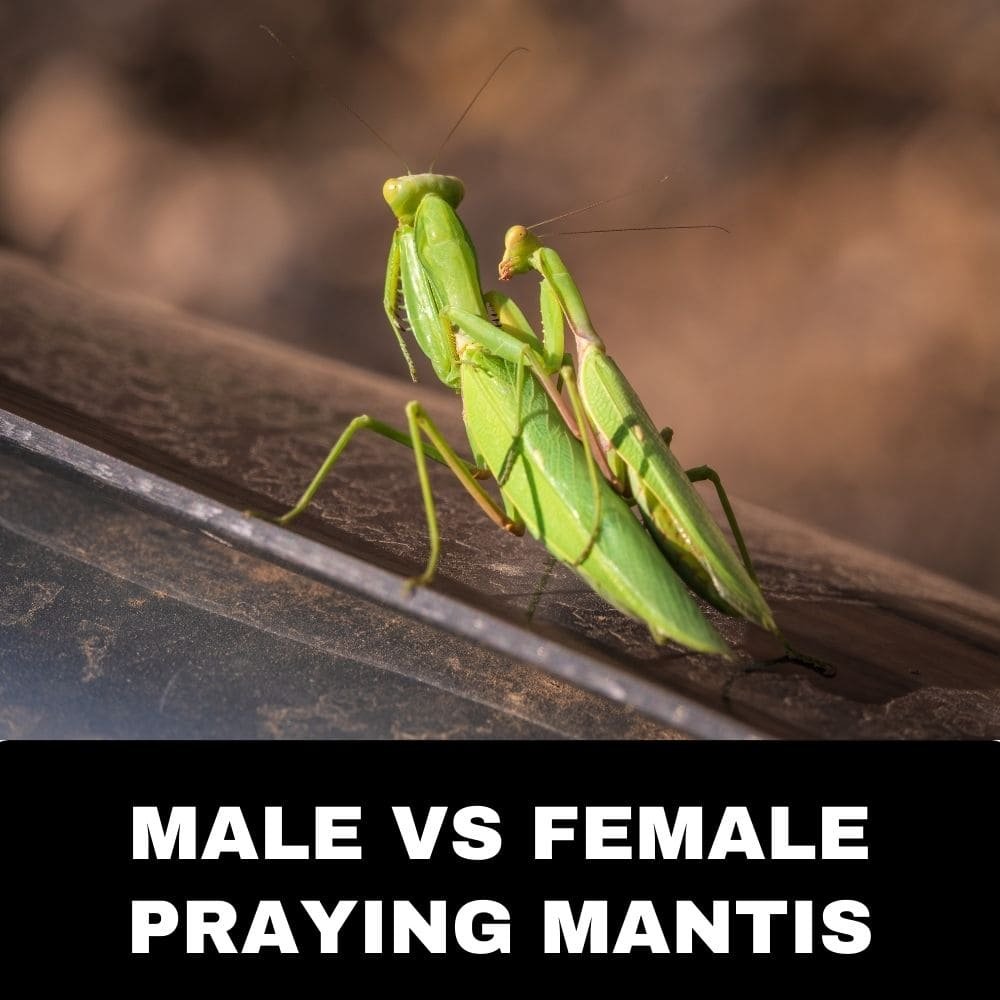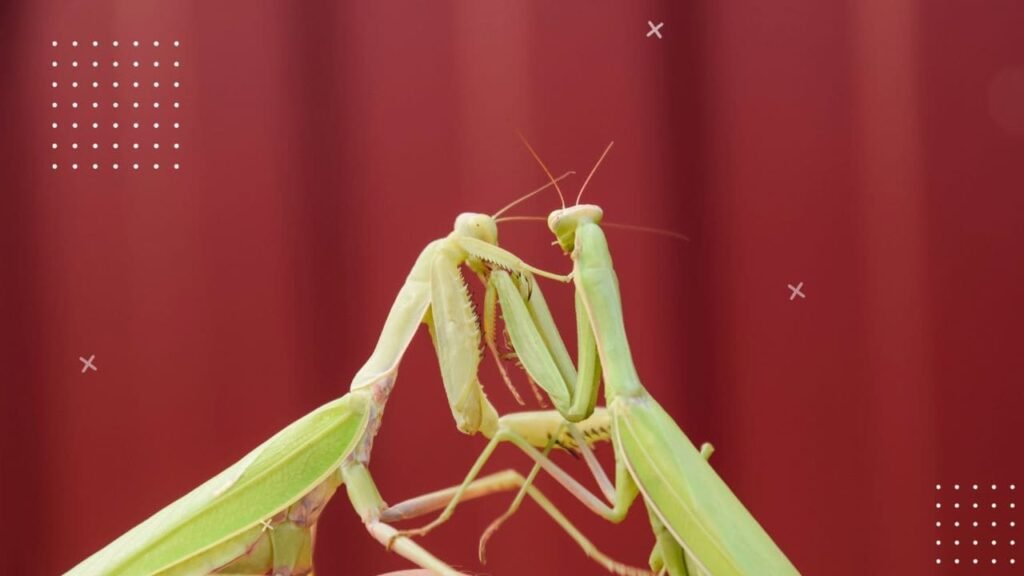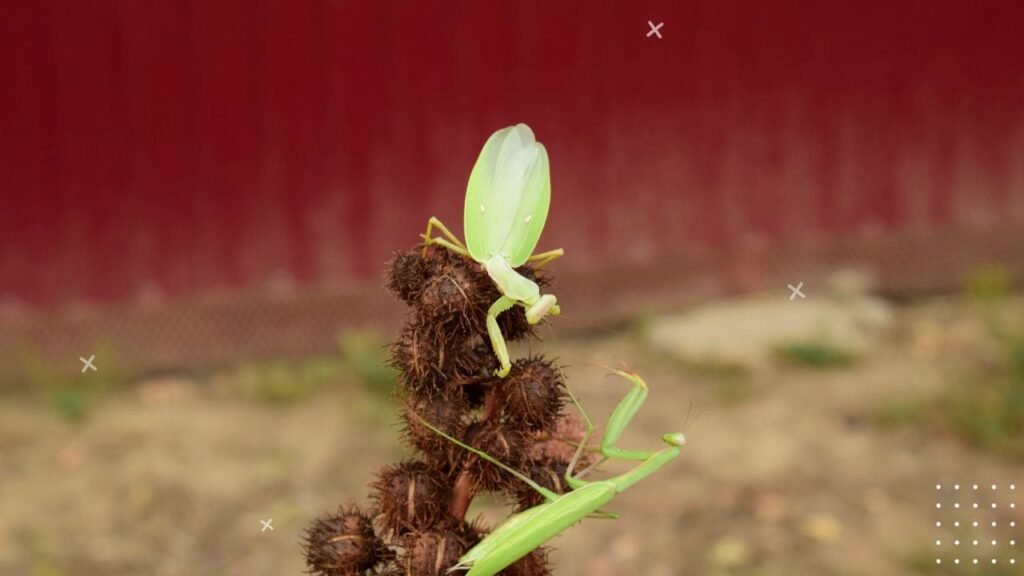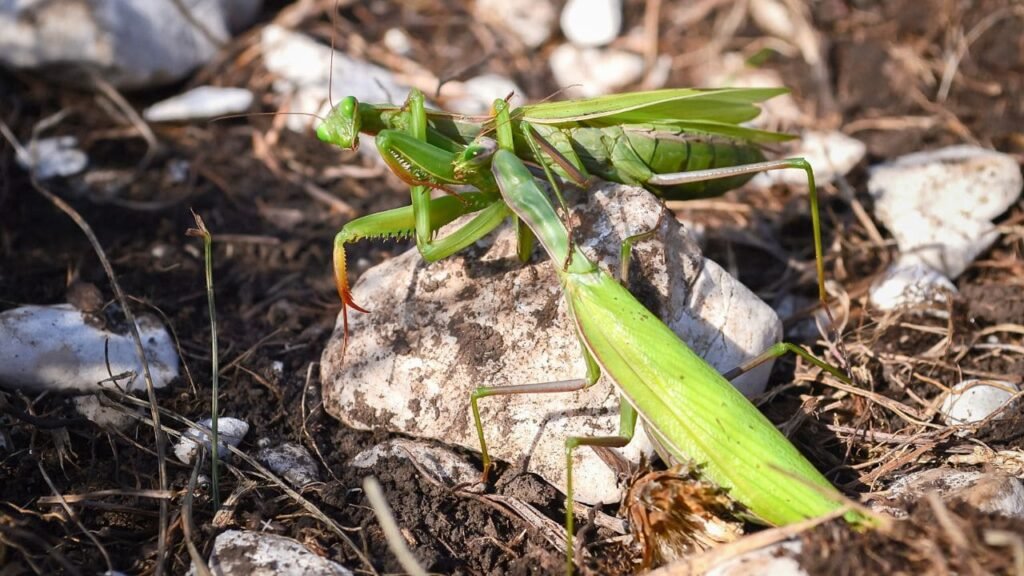


As a kid, I used to love catching little praying mantises that would hang out in my backyard and observing them for hours. Their alien-like appearance always fascinated me with those bulbous eyes, spiky raptorial forelegs, and neat neck-like structure connecting their triangular heads to their bodies.
But it wasn’t until I got older that I realized not all praying mantis species look so similar. Male vs female praying mantis actually have some distinct physical and behavioral differences that set them apart. If you don’t know what to look for, it can even be tricky figuring out if you’re looking at a male or female of the species!
That’s why in this post, I want to highlight seven of the most surprising differences between male and female praying mantis species that many people aren’t aware of. Understanding these distinctions can unlock a whole new level of appreciation for these incredible insects. Plus, it’s just neat to learn about!

One of the most noticeable differences is their sheer physical size. Female mantis species tend to be much larger and broader than males. We’re talking females approaching 6 inches or more in length, while adult males may only clock in around 2-3 inches long. That’s quite the size difference!
I remember catching what I thought was a massive 5 inch mantis in my garden, only to have my entomologist friend inform me that I had caught a female. The petite males zipping around my butterfly bushes were only half her size, so it’s easy to see why I didn’t make the connection at first. But once you know what you’re looking for, it’s hard to miss.
The reason for this size dimorphism largely comes down to the female’s role in reproduction. She has to carry and lay up to several hundred eggs in an egg case, so a larger abdomen is essential. This spectacular abdominal difference between male and female mantis species equips the female to successfully produce offspring.
Meanwhile the male mantis benefits from his smaller size by being lighter and faster, enabling him to take flight and scout around to locate mates more easily. Plus not needing room to house developing eggs allows his body shape to be more streamlined.
So next time you come across a mantis, take a closer look at its size and body shape. Is it a petite and slender male suited for aerial acrobatics? Or a heavier set female prepared to produce the next generation? Once you train your eye, it gets much easier to differentiate males from females.
| Characteristic | Male | Female |
|---|---|---|
| Size | 2-3 inches long | Over 6 inches long |
| Body shape | Slender, elongated | Heavier, broader |
| Wing size | Longer than abdomen | Often no wings or smaller wings |
| Antennae | Long, thin, with many segments | Shorter, thicker, fewer segments |
| Abdomen | Narrower, lighter, 8 complete segments | Broader, heavier, extra “flexible” segment |
In addition to body size, wing size is another tell-tale physical difference between male and female praying mantises worth noting. Male mantis wings are typically longer in relation to their overall body size while females have much smaller wings relative to their bodies. Sometimes female mantis wings are even non-existent!
This extreme wing dimorphism relates strongly to the size differences and reproductive duties mentioned earlier. Those lengthy wings allow males to be agile fliers, efficiently tracking down females by following pheromone trails. Having small or no wings helps the heavier female conserve her energy rather than powering energy-intensive flight. Her wings would get in the way of her egg-filled abdomen anyway!
When looking at mantis wings, remember that males will have wings extending clearly beyond the abdomen while female mantis wings stop at the abdomen or may not even be visible at all. Using this handy cheat can quickly clue you in to whether you’ve spotted a high-flying male or a grounded egg-laying female.

Here’s an odd and surprisingly significant difference to note – male praying mantises actually have way more segments making up their antennae than females of the species. We’re talking double or even triple the segments in some mantis varieties!
These elongated, highly segmented antennae serve an important sensory purpose for males. All those extra antennal segments are densely packed with specialized receptors allowing him to detect airborne pheromones emitted by females looking for a mate. So while his complex antenna may look like overkill, it enables him to pinpoint suitable mates from impressive distances away.
Females on the other hand have no need for such pheromone-detecting equipment, so their antennae remain simple with fewer segments. Checking out the antennal difference between male and female praying mantis species can therefore offer an easy way to tell them apart visually. Just count those antennal segments!
We’ve covered some wild physical differences, but male and female praying mantises also have very distinct behavioral adaptations surrounding reproduction and mating. And these differences mainly come down to risk management.
For the smaller male, approaching a larger and aggressive female is extremely dangerous business. One false move and she may attack and eat him! So male mantises have evolved an elaborate mating “dance” involving cautious approaches interspersed with sudden dashes towards the female while flashing their wings. If she’s suitably receptive, copulation may then occur…albeit at high risk to the male!
Interestingly the female praying mantis has to remain stationary and essentially permit the risky mating initiation from the male. If not receptive she’ll fend him off or even make him her next meal! So she wields ultimate power over deciding whether mating proceeds or not.
These species-specific courtship behaviors offer reliable cues indicating the behavioral differences between male and female praying mantises. If you witness an elaborate and dangerous dance playing out, it’s surely a male cautiously coaxing the attention of a poised female. One wrong move by either party can spell disaster though!
| Characteristic | Male | Female |
|---|---|---|
| Mate seeking | Actively flies around finding mates | Waits sedentary for mate to arrive |
| Mating dance | Complex aerial displays | Remains relatively motionless |
| Cannibalism | Rarely occurs | Much more common |
| Parenting | Dies after mating | Lays ootheca and guards eggs |
| Aggression | Cautious to avoid female’s aggression | Aggressive toward approaching male |
One of the most gruesome facts about praying mantises is that the female will often devour the male during or after mating. This shocking mantis mating behavior certainly seems to reinforce females as the more aggressive and formidable sex.
But despite all the hype, cannibalism doesn’t happen 100% of the time in every mating encounter. Multiple factors are at play, plus rates can vary significantly across mantis species. It also primarily occurs in captivity due to confined spaces as opposed to more natural open settings.
For example, a United Kingdom study found that hungry females kept in cramped spaces were most prone to exhibit mantis mating cannibalism. But females kept isolated from males in roomier enclosures showed no signs of aggression when males were introduced and cannibalism rates were low.
So don’t assume female mantis aggression and meals of mating male partners are a given! Setups causing undue female stress or restricting escape opportunities appear to elevate the risk. Looking at the context and environment provides more insight than viewing this as innate “black widow-esque” behavior in female praying mantises.

We briefly touched on abdominal differences related to egg production, but examining abdomen types is actually one of the most reliable ways to distinguish male praying mantises from females. Let’s explore why.
Female mantises possess a heavier broader abdomen designed to develop and house between 30-400 eggs internally in a structure called the ootheca before being laid. Her abdomen needs to rapidly expand and therefore has an extra “incomplete” segment enabling this flexible expansion. Depending on species her abdomen may change dramatically in size before and after producing an egg case.
Males however have a longer, narrower abdomen tailored to their lean and agile body plan. Rather than housing eggs, his more lightweight slender abdomen contains eight complete hard cuticle segments better suited to speed and aerial maneuvers.
So if you ever have trouble deciphering males from females in the wild, take a good look at the abdomen! A heavier-set, flexible female abdomen built for reproduction differs remarkably from the streamlined and athletic male’s design. Segments and shape offers simple clues to reveal their critical bodily differences.
If you’re considering keeping praying mantises as pets, their captive care needs often depend on gender. Let’s explore key considerations:
Enclosure Size – Females require more space for egg-laying. Aim for an enclosure at least 3 times the mantis length. Males need less space so 2 times mantis length usually suffices.
Feeding – Well-fed females still may cannibalize males as prey is interpreted differently. Always monitor initial meetings.
Temperature & Humidity – Heat lamps usually unnecessary but misting helps males molt properly. Females need additional humidity for laying egg cases.
Life Span – Females typically live 4-6 months as adults since they persist to lay eggs. Adult males often only live 2-3 months after final molt since mating ends their purpose.
Behavioral Enrichment – Make sure males have vertical sticks and mesh for hanging to stimulate natural behavior. Add foliage for the more terrestrial female’s habitat needs.
Egg-Laying – Expect this a few weeks after mating! Be prepared to safely transfer ootheca to incubate eggs. Hatching nymphs require meticulous care.
With the right information and setup, both male and female praying mantises can make fascinating exotic pets. Just be sure to tailor their habitat and care based on their unique biological requirements as adults. Understanding what differs between the sexes ensures you can provide proper care!
As you can see, male and female praying mantises exhibit an array of surprising physical, sensory and behavioral adaptations that differentiate the sexes. Getting to know these unique hallmarks provides great insight into these incredible insects beyond the usual fascination with their raptorial forelegs and predatory nature.
Over millions of years, mantises evolved specialized physical attributes and mating behaviors that increased their chances of reproductive success. But why did the mantis species develop such significant gender differences along the way? Scientific theories seeking to explain this point to something called sexual selection.
Essentially, certain traits give males and females of a species evolutionary advantages in the mating game. The mating dance of the male mantis likely evolved because females preferred males that could demonstrate fitness and vigor through elaborate aerial displays. Likewise, cannibalism may have emerged because females with the aggression to gain additional nutrition could lay more eggs.
So while dramatic and even shocking to our human sensibilities, the odd qualities differentiating male vs female praying mantises have specific evolutionary purposes. These specialized gender differences helped praying mantises pass on traits most likely to thrive and endure over successive generations.
While much remains unknown about mantis evolution, unlocking origins of their eccentric qualities brings us one step closer to appreciating them as the highly adapted insects they are today.

Whether observed in captivity or out in gardens and grasslands, praying mantises reveal many distinctive qualities based simply on gender. So next time you come across one of these mantids, take a moment to notice key indicators like wing size, abdomen shape, antennal complexity and demeanor. These clues can unlock if you’re observing a fit and agile male or a sturdy and egg-laden female.
Understanding the spectrum of differences between male vs female praying mantis species equips you to appreciate them on a deeper level and makes identifying either that much easier. With a trained eye you’ll be determining males from females like a pro – and wowing your friends with your impressive knowledge to boot!
So grab a hand lens or macro lens for your camera and explore the captivating world of male and female praying mantises near you. I guarantee once you know what makes them unique, you’ll only grow more fascinated by these exotic insects we’re so fortunate to share our world with!
Why are female praying mantises so much bigger than males?
The size difference is an evolutionary adaptation that enables females to produce and carry the egg cases. Females need large, heavy abdomens to house 200-400 eggs internally before mating. Their heavier body size also deters some predators. Meanwhile males remain small, light, and agile so they can easily fly around to locate mates.
Do praying mantises bite humans?
Wild praying mantises typically won’t bite humans and their jaws usually can’t pierce human skin. However, captive female mantises can mistake fingers as prey. During handling they may “nibble” in investigatory bites without causing harm or breaking skin. Males hardly bite at all. But it’s still wise to avoid contact with their sharp raptorial forelegs.
How can you tell a male praying mantis from a female?
The easiest ways to distinguish males vs females is by checking 1) body and abdomen size and shape, 2) comparing wing sizes, and 3) noting antennae segment differences. Females are larger and broader-bodied, especially the abdomen for housing eggs. They have reduced wings or no wings at all. Males are smaller with long, thin highly segmented antenna and clearly visible wings longer than their abdomens.
Do praying mantises make good pets?
Praying mantises do make fascinating exotic pets since they are interactive predators that are fun to feed and observe. However, they require very specific care and housing considerations depending on gender, life stage, and species. Be sure to research thoroughly before deciding if praying mantises are suitable pets for your household.
Why do female mantises eat the males after mating sometimes?
Cannibalism offers females a protein-rich meal that can aid in egg production. But rates in the wild are much lower than in confined captivity. Crowded spaces, insufficient food sources, and stressed insecure females are more prone to see the male as prey post-mating and eat him. Providing ideal conditions can significantly reduce the chances of mating cannibalism.